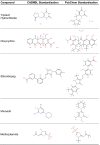An open source chemical structure curation pipeline using RDKit
- PMID: 33431044
- PMCID: PMC7458899
- DOI: 10.1186/s13321-020-00456-1
An open source chemical structure curation pipeline using RDKit
Abstract
Background: The ChEMBL database is one of a number of public databases that contain bioactivity data on small molecule compounds curated from diverse sources. Incoming compounds are typically not standardised according to consistent rules. In order to maintain the quality of the final database and to easily compare and integrate data on the same compound from different sources it is necessary for the chemical structures in the database to be appropriately standardised.
Results: A chemical curation pipeline has been developed using the open source toolkit RDKit. It comprises three components: a Checker to test the validity of chemical structures and flag any serious errors; a Standardizer which formats compounds according to defined rules and conventions and a GetParent component that removes any salts and solvents from the compound to create its parent. This pipeline has been applied to the latest version of the ChEMBL database as well as uncurated datasets from other sources to test the robustness of the process and to identify common issues in database molecular structures.
Conclusion: All the components of the structure pipeline have been made freely available for other researchers to use and adapt for their own use. The code is available in a GitHub repository and it can also be accessed via the ChEMBL Beaker webservices. It has been used successfully to standardise the nearly 2 million compounds in the ChEMBL database and the compound validity checker has been used to identify compounds with the most serious issues so that they can be prioritised for manual curation.
Keywords: ChEMBL; Chemistry; Curation; Open source; RDKit; Standardisation.
Conflict of interest statement
The authors have no competing interests.
Figures






References
-
- Dalby A, Nourse JG, Hounshell WD, Gushurst AKI, Grier DL, Leland BA, Laufer J. Description of several chemical structure formats used by computer programs developed at molecular design limited. J Chem Inf Comput Sci. 1992;32:244–255. doi: 10.1021/ci00007a012. - DOI
-
- Weininger D. SMILES, a chemical langaugeand information system. 1. Introduction to methodology and encoding rules. J Chem Inf Comput Sci. 1988;28(1):31–36. doi: 10.1021/ci00057a005. - DOI
Grants and funding
LinkOut - more resources
Full Text Sources

